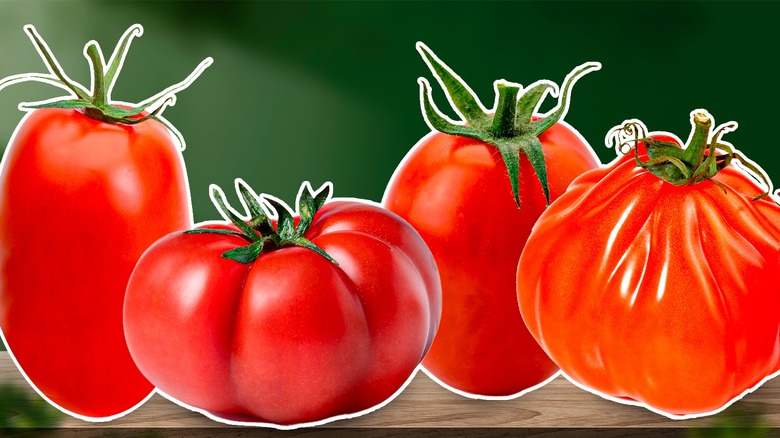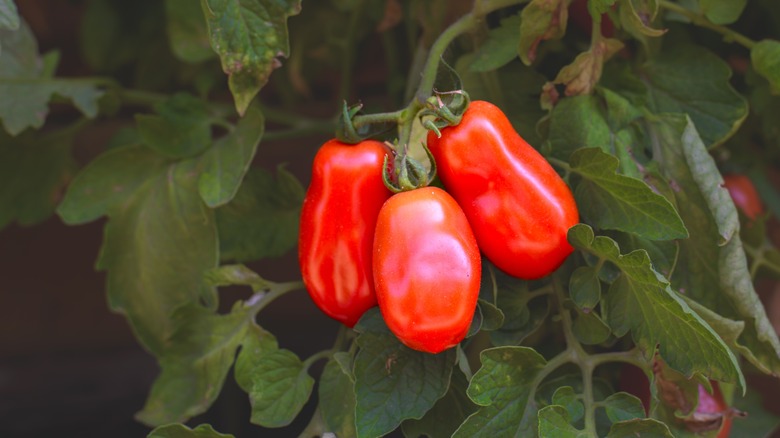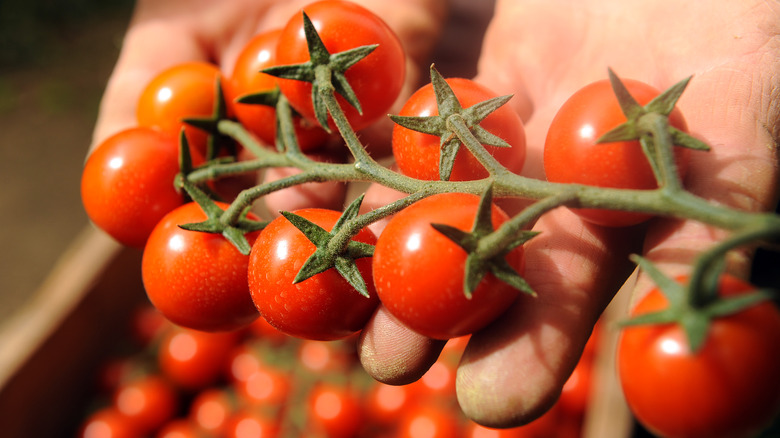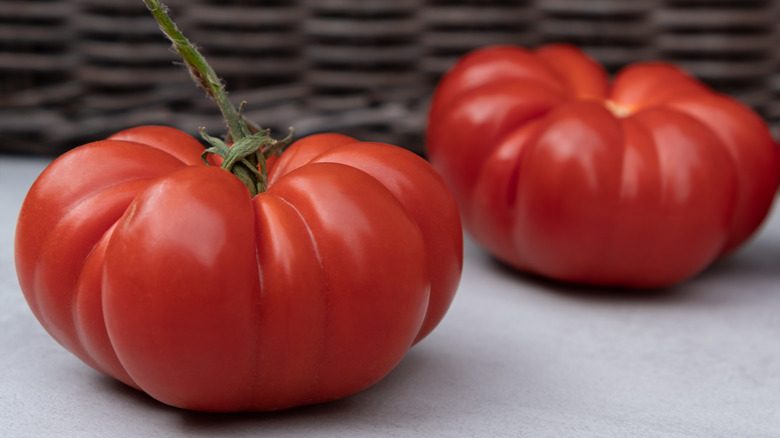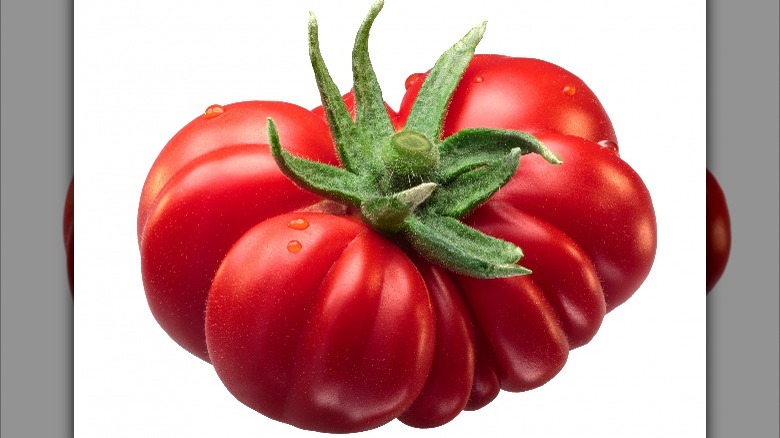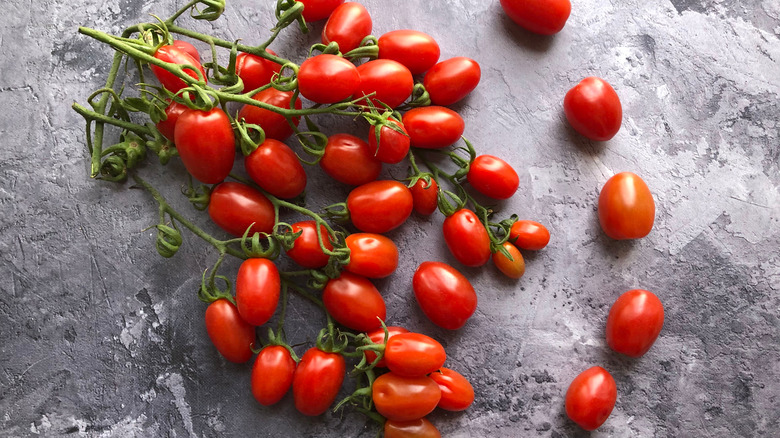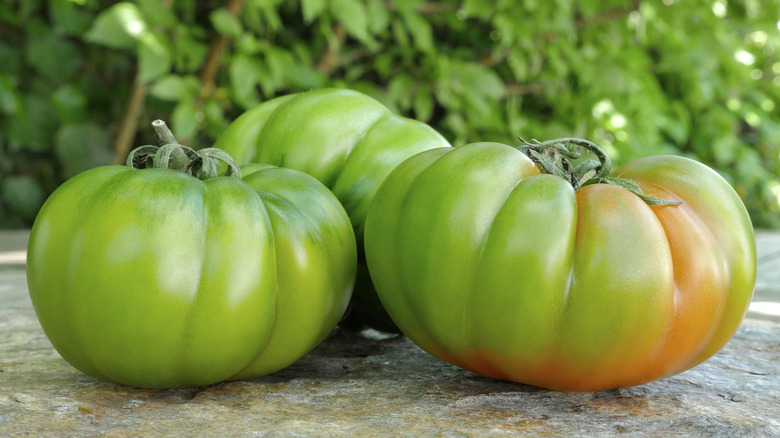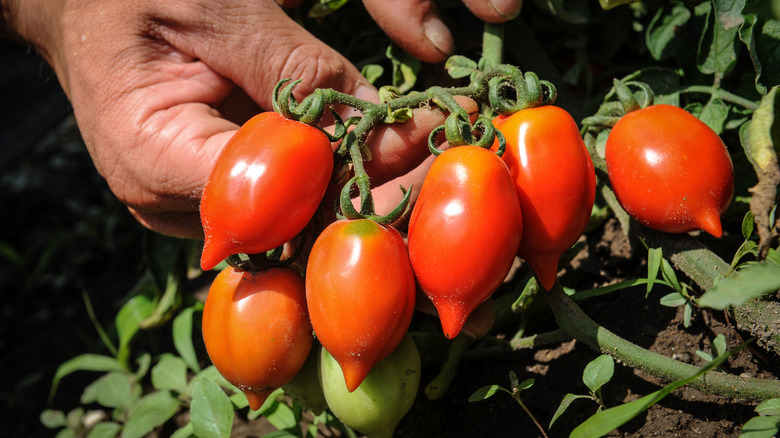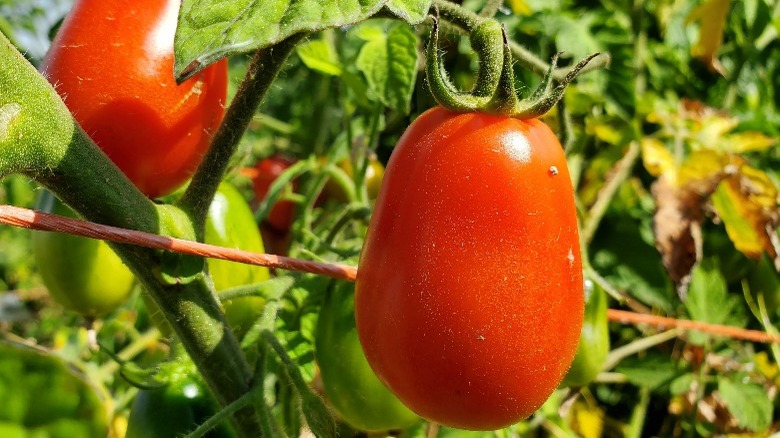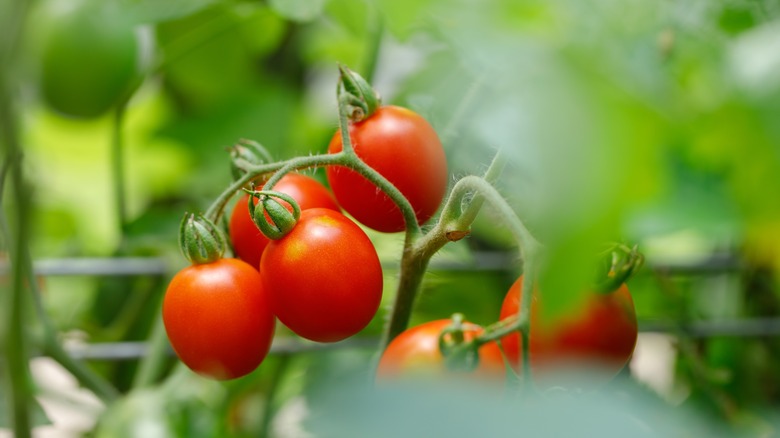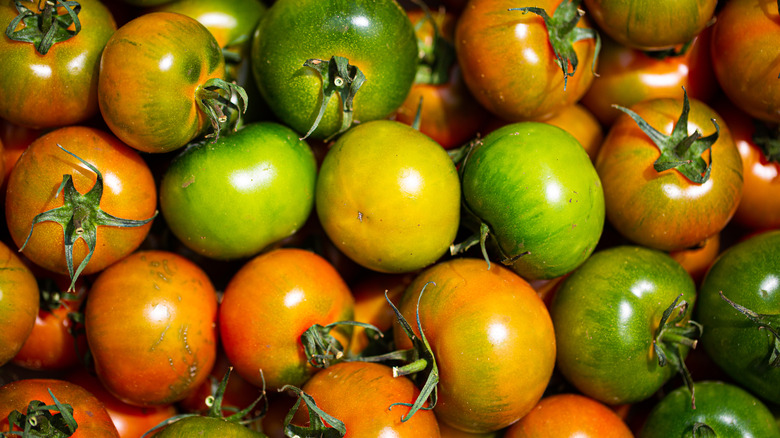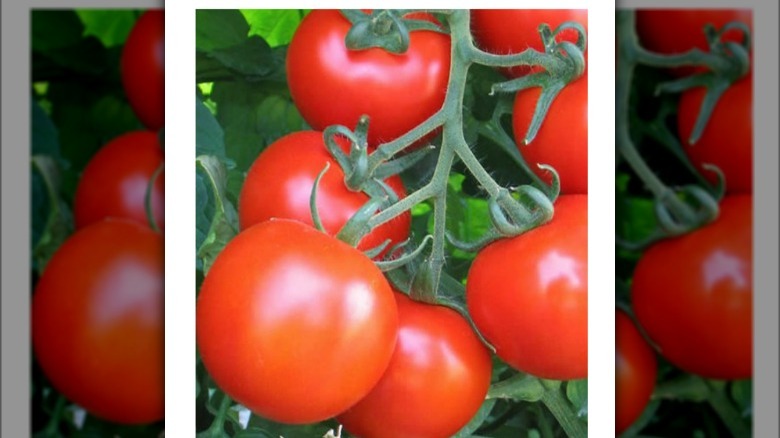11 Italian Tomato Varieties To Get To Know
Originally hailing from Latin America, the tomato found its perfect home in the sunny southern regions of Italy during the 15th century. Italians soon adopted this juicy red fruit (yes, it's classified as a fruit),and began using it a variety of delectable dishes.
There's nothing quite like the taste and smell of a perfectly ripe Italian tomato. From Vesuviani tomatoes that are grown in the mineral-rich volcanic soil of Mount Vesuvius, to the world-renowned San Marzan tomato, which is famous for creating the most authentic Italian sauces, each variety is simply delicious. A dash of quality sea salt is all you'll need to savor the flavors.
1. San Marzano
San Marzano tomatoes have become a symbol of Italian excellence, celebrated by food enthusiasts worldwide. Every authentic pizzeria worth its salt uses them, while many authentic Italian restaurants swear by them. These tomatoes are long and slender with a unique pointed tip and are less seedy than the regular plum variety. The rich aroma has subtle hints of spice and herbs that will surely draw you in, and just looking at their deep, dark red color makes your mouth water. Their firm texture and sweet, earthy flavor make them ideal for sauces and salads.
The southern Italian region where San Marzano tomatoes are grown boasts volcanic soils, which endow them with their renowned flavor — a delightful blend of sweetness, rich tomato intensity, and balanced acidity. These precious tomatoes are also adorned with the PDO (Protected Designation of Origin) seal, which guarantees their origin and quality. Today, San Marzano tomatoes can be cultivated outside of Italy, including in the U.S., although surpassing the authentic variety takes a lot of effort simply because it is hard to mimic pristine Italian soil conditions. And while finding these fresh tomatoes in season sounds like an elusive idea (unless you're in Italy), you can find quality tinned San Marzano's at your local Italian specialty shop.
2. Pomodoro di Pachino
The Pomodoro di Pachino IGP is a certified trademark that guarantees the authenticity of various Sicilian tomatoes. These four distinguished varieties are known for their unique characteristics and exceptional taste. The tondo-liscio (round-smooth) type of tomato boasts a compact, circular shape, deep green color, and rich flavor. On the other hand, Grappolo (cluster) tomatoes have a smooth, circular form and varying weights based on the soil's salinity. The costoluto (ribbed) tomatoes are easily distinguishable due to their large size, prominent ridges, and deep green hue. Lastly, the ciliegino (or cherry) type of tomatoes looks like clusters of cherries featuring small, circular fruits with striking colors.
The abundant sunlight, high temperatures, mild climate, and quality irrigation water contribute to the delightful sweetness, firm and crunchy flesh, and vibrant color of all four Pomodoro di Pachino IGP varieties. Sicilians love to dry the tomatoes and preserve them in extra-virgin olive oil, but for the ultimate experience, Pachino tomatoes are best enjoyed raw, mixed into Mediterranean pasta salad, or used as a top-notch pizza topping.
3. Cuore di Bue
The Cuore di Bue, or oxheart tomato, is fascinating due to its distinctive heart-shaped appearance. It takes its name from its elongated shape, reminiscent of an ox's heart — a fitting description for such a large tomato. These tomatoes are among the largest grown in Italy, often reaching the size of a softball and weighing up to 1 pound each. Some exceptional specimens can even exceed 3 pounds in weight.
The Cuore di Bue tomato is a prominent member of the heirloom beefsteak variety, providing a meaty texture and few seeds. The original Italian breed boasts an impressive array of colors. Typically, they are orange-red with green shoulders but can also be found in deep red, pink, orange, green, and even purple hues.
The versatility of oxheart tomatoes is limitless. They can be enjoyed fresh in classic dishes like Caprese salad, highlighting their remarkable taste and texture. Furthermore, they are perfect for sauces and soups, making them a desirable ingredient for various recipes, such as creating passata: The Italian secret to upgrading any tomato sauce.
4. Costoluto Fiorentino and Genovese
The Costoluto tomatoes, including the Genovese and Fiorentino varieties, have a unique look with flattened shapes and deep, asymmetrical ribs. Despite their wrinkly appearance, their exceptional flavor more than makes up for it. These tomatoes are meaty with a high flesh-to-seed ratio and are among the largest in Italy, often weighing up to a pound each.
Originating from Genoa, Liguria, the consolute Genovese is slightly larger and sweeter than its Fiorentino counterpart. It's a very old variety grown at Thomas Jefferson's Monticello as early as the 1800s. On the other hand, the Costoluto Fiorentino comes from Florence, Tuscany, and is flatter and smaller, with a slightly less sweet taste.
The Costoluto Genovese boasts large fruits with a fruity, aromatic taste, while the Costoluto Fiorentino has firm, sweet, and juicy red flesh. Both varieties are perfect for Mediterranean-style recipes and can be enjoyed sliced on bread or whisked into authentic Italian tomato sauce.
5. Datterini
Datterini tomatoes are a delightful heirloom variety from Southern Sicily that was rediscovered about two decades ago. The name "datterini" comes from their resemblance in size, shape, and sweetness to dates. These tomatoes have a thick, soft skin, few seeds, and are known for their exceptional sweetness and richness. They're delicate and cook quickly, but equally fantastic raw.
While they're often mistaken for cherry tomatoes, datterinis are, in fact, mini plum tomatoes, most commonly found in red and yellow varieties. The yellow type is sweeter, possibly the sweetest of all tomato varieties. Their sugary notes pair beautifully with a wide range of dishes, while roasting gets them extra caramelized, perfect as a side dish or added to a hearty bacon, lettuce, avocado, and tomato sandwich.
It can be tough to find fresh datterini tomatoes, especially if you're not in a major city. Nonetheless, your chances may be better in an area with a large Italian population. You can also check farmers' markets when datterini are in season. If you can't find them fresh, try the canned or jarred versions, which are often available at Italian grocery stores.
6. Marinda
The roots of Marinda tomatoes can be traced back to France, where a related heirloom variety was first cultivated in the city of Marmade. The exact lineage may remain a mystery, but they eventually made their way to Sicily, where they flourished in the unique coastal environment. The salty soil and water contribute to the unparalleled flavor profile for which Marinda tomatoes are known.
In the small town of Pachino, famous for Marinda tomatoes, the art of stressing tomato plants is used to enhance their flavor. The winter temperatures, saltwater, and controlled rainfall all work together to allow the plants to absorb essential minerals and salts from the soil, resulting in a distinguished and complex flavor. Marinda season signals the arrival of spring in Pachino, and locals celebrate by savoring these remarkable tomatoes paired with their favorite local wines.
What sets them apart is their distinctively thick, ridged skin that provides a crunchy texture. As they ripen, they transition from green to shades of orange and red, with dark green patches on the shoulders as a visual indicator of their quality. Marinda tomatoes have a salty profile with a firm, slightly tart pulp. The best way to enjoy them is raw or in salads, as their unique qualities truly shine through. For optimal taste, savor them when they still have a touch of green.
7. Piennolo del Vesuvio
The Piennolo del Vesuvio PDO tomato is a quintessential component of Neapolitan cuisine. One of the few growers with PDO distinction, the Imperato family has been cultivating Piennolo on the Sapori Vesuviani farm near Naples for generations. They began producing the tomato on a larger scale in 2009, which was only made possible due to the prestigious PDO certification, thus saving a near-extinct species.
The tomato fields in Piennolo are located on a Vesuvian seaside hillside, benefiting from the volcanic soil and cool coastal breeze, enriching these tomatoes with an exquisite aroma. The Piennolo del Vesuvio PDO tomato has a delicious taste, characterized by its sweetness with a hint of bitterness and sourness. This flavor profile directly results from the mineral-rich volcanic soil, particularly in potassium and sulfur.
The culinary possibilities of Piennolo tomatoes are endless. They pair exceptionally well with seafood, add flavor to pizzas and bruschetta, and beautifully complement buffalo mozzarella. The tomato's intense and complex flavor makes it ideal for creating exquisite sauces and enhancing dishes of renowned pizzerias and Italian restaurants.
8. Corbarino
The charming village of Corbara, nestled on the slopes of Monti Lattari in Campania, Italy, is home to the prized Corbarino tomato variety. These pear-shaped berries boast a unique, sweet, tangy flavor that sets them apart from other tomatoes. The Corbarino tomato is believed to have originated from ancient preserved varieties grown in the area. Although traditionally grown in the hills, it can now be found in lowland areas, maintaining its exceptional qualities.
The Campania region has become famous for cultivating tomatoes, showcasing a variety of indigenous types. Corbarino is by far one of the most treasured varieties in the area and has a distinct flavor partly thanks to the temperate climate, which is influenced by the nearby sea and sirocco winds. Despite gaining recognition beyond its borders, it remains a beloved niche product.
The Corbarino tomato is a highly versatile ingredient that can be utilized in various culinary contexts, fresh or preserved. Its slightly tangy flavor makes it an ideal addition to refreshing salads, mouthwatering sauces, and seafood-based dishes.
9. Principe Borghese
The Principe Borghese tomato is a stunning heirloom variety that originally hails from Mexico but was brought to Italy around 1910. These small, plum-shaped tomatoes typically measure 1 to 2 inches. They have a relatively dry, deep-red, meaty flesh compared to other tomato varieties. This characteristic makes them perfect for sun-drying or dehydration. When dried, they retain more flavor than most other varieties, so they are highly favored in Italy for producing sun-dried tomatoes. The Principe Borghese is known for its heat tolerance and hardiness, making it a popular choice for warmer regions in the U.S. as well.
The vibrant fruits of Principe Borghese boast a rich, classic tomato taste, making them ideal for preparing flavorful tomato sauces. When eaten fresh, they add a delightful touch to sandwiches or soups. Given their smaller size, Principe Borghese tomatoes are particularly well-suited for fresh salads, where their rich and tangy tomato flavor truly shines.
10. Camone
The Camone tomato is a rare variety from Italy's Sardinia and Sicily regions. It thrives in saline soil and has a thin skin that starts off orange and turns dark green as it ripens. The history of Camone tomatoes dates back to a Swiss agricultural company that aimed to cultivate a stable and prolific variety. The tomatoes eventually found their way to Sardinia in the 1980s, where they were planted in sandy soil and nourished with salty seawater. This unique process, although time-consuming, resulted in fully-ripened fruits with an exceptional taste and texture. Camone tomatoes are still hand-cultivated and harvested exclusively in Italy.
This variety is distinguishable by its round shape and captivating red-green color. It has a satisfyingly fresh and crispy texture and is sweet with a subtle acidity. The flesh is buttery and juicy, making it a versatile ingredient that can be used in a variety of recipes. Whether you're making a salad or a fresh dish that calls for a tomato with excellent texture, abundant flavor, and vibrant color, the Camone shines all the way.
11. Regina
The sun-kissed Coastal Dune Park in southeastern Italy is home to a tomato variety fit for royalty. The Regina, also known as the tomato queen, gets its name from the crown-like shape of its peduncle. The cultivation of this variety began in the mid-1800s, replacing cotton plantations. The original seeds of the Regina tomato, carefully preserved by local farmers, have adapted remarkably well to the hot and arid terrain.
Regina tomatoes have thick skin due to irrigation with seawater. This unique characteristic allows them to be stored for several months after harvest, through late winter. The Italian Regina tomato is highly regarded for its rich, sweet flavor and fragrant aroma. It's an excellent variety for those who enjoy roasted or grilled tomatoes, as cooking only enhances their natural sweetness and can add depth and complexity to any dish.
In 2008, the Regina tomato gained recognition through a critical study supported by the Puglia Region's Rural Development Program 2014 – 2020 (per MDPI Journal of Agriculture), focusing on Puglia's biodiversity in vegetable crops. The experiment confirmed that it has high levels of antioxidants and low levels of glucose and fructose compared to other tomato varieties, making it a superior nutritional choice.
